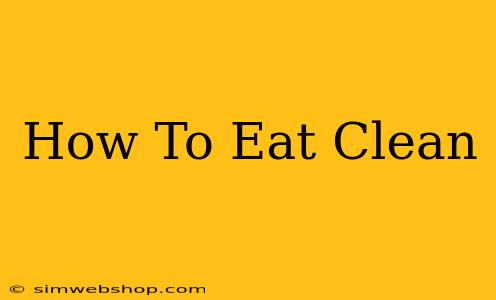Eating clean isn't about strict diets or deprivation; it's a lifestyle choice focused on nourishing your body with whole, unprocessed foods. This guide will walk you through the essentials of clean eating, helping you make sustainable changes that benefit your health and well-being.
Understanding the Principles of Clean Eating
At its core, clean eating emphasizes consuming foods in their most natural state. This means minimizing processed foods, added sugars, unhealthy fats, and artificial ingredients. Instead, you'll focus on:
- Fruits and Vegetables: These are packed with vitamins, minerals, and antioxidants. Aim for a colorful variety to maximize nutrient intake.
- Lean Proteins: Choose sources like chicken breast, fish, beans, lentils, and tofu. Protein is crucial for building and repairing tissues.
- Whole Grains: Opt for brown rice, quinoa, oats, and whole-wheat bread over refined grains. These provide sustained energy and fiber.
- Healthy Fats: Include sources like avocados, nuts, seeds, and olive oil. These are essential for brain function and hormone production.
What to Avoid (or Minimize) in a Clean Eating Plan
While focusing on what to include is key, understanding what to limit is equally important. Try to reduce or eliminate:
- Processed Foods: This includes packaged snacks, fast food, and pre-made meals, often high in sodium, unhealthy fats, and added sugars.
- Added Sugars: Look for hidden sugars in sauces, dressings, and even seemingly healthy foods. Limit sugary drinks and desserts.
- Unhealthy Fats: Trans fats and saturated fats found in fried foods and processed snacks should be minimized.
- Artificial Ingredients: Be mindful of food additives, preservatives, and artificial colors.
Practical Tips for Implementing a Clean Eating Plan
Transitioning to clean eating doesn't have to be overwhelming. Start with small, manageable changes:
1. Plan Your Meals:
Planning ahead prevents impulsive unhealthy choices. Prepare a weekly meal plan and grocery list to stay organized.
2. Cook More Often:
Cooking at home allows you to control ingredients and portion sizes. Experiment with simple, healthy recipes.
3. Read Food Labels Carefully:
Pay attention to serving sizes, ingredients, and nutritional information. Learn to identify hidden sugars and unhealthy fats.
4. Gradually Eliminate Processed Foods:
Don't try to change everything at once. Gradually replace processed foods with healthier alternatives.
5. Stay Hydrated:
Drink plenty of water throughout the day. Water aids digestion and helps you feel full.
6. Listen to Your Body:
Pay attention to your hunger and fullness cues. Eat mindfully and savor your food.
Benefits of a Clean Eating Lifestyle
The rewards of adopting a clean eating approach extend far beyond weight management. You can expect:
- Increased Energy Levels: Whole foods provide sustained energy, reducing crashes and fatigue.
- Improved Digestion: Fiber-rich foods promote healthy digestion and regularity.
- Better Sleep: A balanced diet contributes to better sleep quality.
- Stronger Immune System: Nutrient-rich foods support immune function.
- Improved Mood: A healthy diet can positively impact mental health and well-being.
- Weight Management: Clean eating naturally helps control calorie intake and promotes weight loss or maintenance.
Clean Eating is a Journey, Not a Destination
Remember, clean eating is a long-term lifestyle change, not a quick fix. There will be days when you slip up, and that's okay. The key is to get back on track and continue striving for a healthier, more balanced diet. Don't be afraid to experiment, find what works best for you, and enjoy the process of nourishing your body with wholesome foods.

